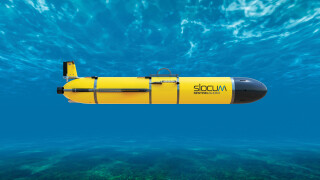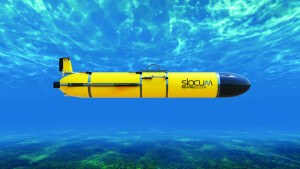

Commercially Viable Species Population Monitoring with the Teledyne Webb Slocum Glider
Overview
Researchers at the University of Alaska Fairbanks (UAF) College of Fisheries and Ocean Sciences have been leading innovative research into tracking salmon migration patterns, habitat utilization, and monitoring commercial crab populations in the high-latitude waters of the Arctic and North Pacific Oceans. These efforts are underpinned by advanced technology, such as the Teledyne Slocum Glider, which is integral to the University’s research endeavors. The UAF Autonomous Underwater Vehicle Glider Lab is addressing key management questions with help from the Teledyne Webb Slocum Glider. Their research provides real-time environmental data using Teledyne Marine’s Autonomous Underwater Vehicle (AUV) technol-ogy for commercial fisheries applications.
The Teledyne Slocum Glider: A Game-Changer
The Teledyne Slocum Glider, an autonomous underwater vehicle (AUV) from the UAF Glider Lab, is renowned for its adaptability in marine research. Equipped with cutting-edge sensors, including acoustic receivers and advanced navigation systems, the Glider is an exemplary tool for tracking and monitoring marine species, align-ing with UAF’s mission to support the growth of Alaska’s blue economy.
Salmon Tracking in the Pacific
Focusing on tracking salmon in the northern waters of Alaska, the researchers are gathering crucial data for ecological conservation and fisheries management. Using the Slocum Glider, they navigate autonomously through the Bering Sea and the Gulf of Alaska, capturing signals from tagged salmon. This research is paramount as salmon are essential to the region’s ecosystem, and the insights gained contribute significantly to the man-agement and sustainability of salmon populations.
Monitoring Commercial Crab Populations
Beyond salmon, the Slocum Glider is also pivotal in assessing the health of commercial crab populations. Sustainable management of these populations is vital for the industry, which forms a significant part of Alaska’s economy. By surveying the seabed and using advanced imaging and sonar technology, the Glider provides invaluable data to fisheries managers, aiding in the decision-making process for catch quotas and conservation measures.
Conclusion
The work of the researchers at the University of Alaska Fairbanks significantly contributes to marine biology and fisheries management in the Arctic region. The Slocum Glider has emerged as an indispensable tool for precisely tracking marine life and monitoring commercial fisheries. Its autonomous operation, advanced sensors, and ability to withstand harsh conditions have revolutionized marine research. As the global ocean economy grows, the Glider’s role in informing sustainable management of marine resources becomes ever more crucial, ensuring that Alaska remains at the forefront of marine research and conservation efforts.
Do you have questions about this case study?
Get in touch with Teledyne Marine, and they would be happy to answer any questions you have about pricing, suitability, availability, specs, etc.
Related articles






![Do-Giant-Tortoises-Make-Good-Neighbors-1[1].jpg](https://cdn.geo-matching.com/vRMO2Edp.jpg?w=320&s=a6108b2726133ff723670b57bc54c812)



